How to Set Up Chrome Kiosk Mode?
Businesses implement digital signage to increase revenue via advertising
Offices and educational institutions configure computers for limited access
They all leverage powerful kiosk technology. And Chrome kiosk mode, known for its security and stability, is widely adopted.
Here we will explore the setup methods for Chrome Kiosk mode, the features offered by different approaches, common FAQs that trouble most users, and their solutions.
1 How to Set Up Chrome Kiosk Mode?
The setup methods vary for different devices. Before you begin, please confirm the device's operating system and your specific requirements to select the appropriate method from below.
1.1 Managed ChromeOS Devices
Managed ChromeOS devices typically refer to Chrome devices managed by enterprises or educational institutions, equipped with Chrome Enterprise or Education licenses, and can be managed through Google Admin.
Using the Google Admin console, administrators can remotely and centrally manage multiple devices, configure/deploy/update, and monitor device status in bulk.
- Step 1:Log in to Google Admin console
- Use your credentials to log in to the Google Admin console, and navigate to the menu: Devices > Chrome > Apps & Extensions > Kiosk.

- Step 2:Chrome Kiosk Mode Setup
- Select the Chrome app for lockdown, and configure deployment and launch settings. You can choose Public Session Kiosk or Auto-Launch Kiosk App.

- Step 3:URL List
- In Chrome > Settings tab, you can set URL blocking, which supports up to 1000 URLs.

- Step 4:Chrome Version Conrol
- You can also specify the required_platform_version in the manifest and then block automatic app updates in Google Admin to avoid compatibility issues caused by updates.
- Step 5:Verification
- After completing the setup, verify the settings on the managed device: restart the Chrome device and check the lockdown status.
What This Method Can Do for You
- Chrome auto-launch
- Prevent browser from closing and unauthorized access
- URL blocking
- Kiosk troubleshooting
1.2 Non-managed ChromeOS Devices
This method is suitable for restricting ChromeOS devices for personal use, or locking down Chrome browser on a single device in commercial scenarios.
- Step 1:Enable Developer Mode
- Open Chrome browser and go to chrome://extensions, enable Developer Mode at the top right of this page.

- Step 2:Chrome Lockdown
- Click on Manage kiosk applications and enter the Chrome app ID. Click done.
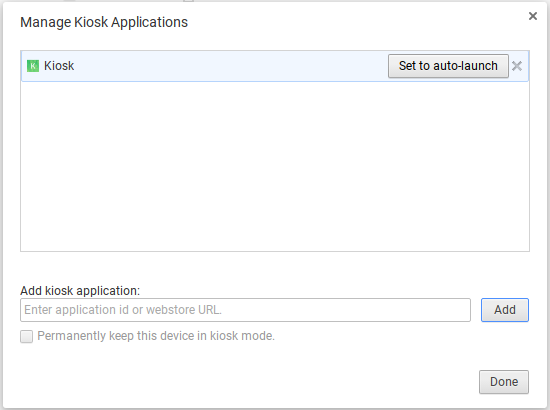
- Step 3:Restart the Device
- After restarting or logging into the device, Chrome kiosk mode will automatically launch.
Tips:
- Developers can leverage ChromeOS Dev documentation and PWA technology to deliver advanced features like offline functionality and hardware API access in Chrome kiosk mode.
1.3 Single Windows Device:Add Chrome As Shortcut Tab
Follow these steps to quickly set up a Windows device running into Chrome kiosk mode. And users cannot exit without a keyboard.
- Step 1:Open Chrome
- Open the Google Chrome browser on your Windows 10/11 OS device and look for the profile icon at the top-right corner of the screen.
- Step 2:Create A Shortcut
- Select the profile you want to create a shortcut for. Click the pencil icon labeled "Customize Profile." Enter a name for your Chrome profile, choose a theme color, and select an avatar. Toggle the "Create desktop shortcut" switch to blue. A Chrome shortcut for this profile will then appear on your desktop.

- Step 3:Move to Desktop
- Now close all the Chrome tabs and move to the desktop. You will find your Chrome shortcut there.

- Step 4:Manage Properties
- Right-click on the tab and choose the ‘Properties’ option.
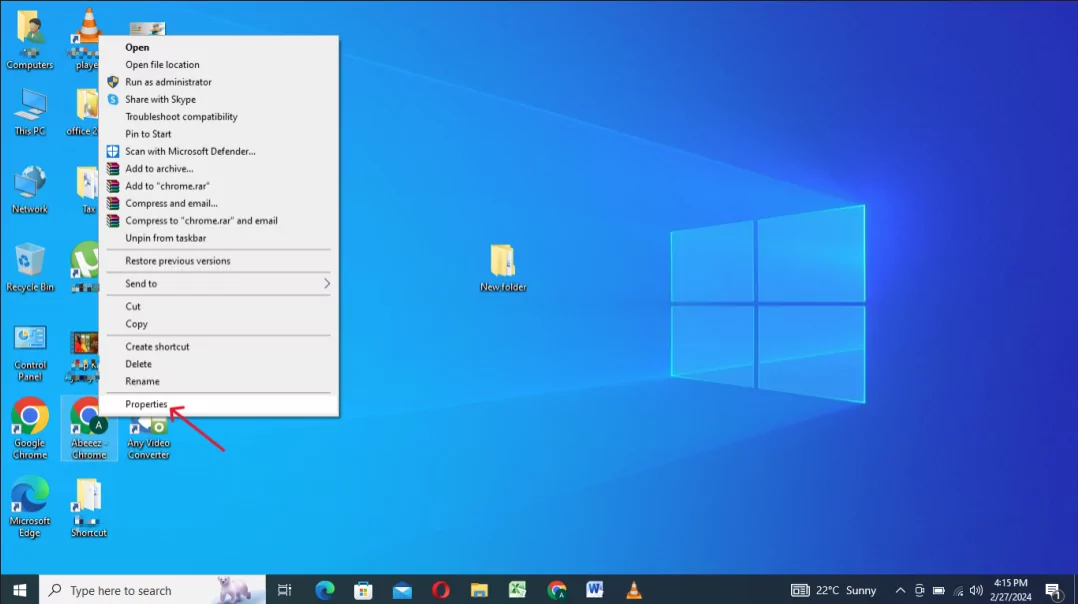
- Step 5:Select the ‘Shortcut’ option
- Click on the Shortcut option, and add ‘- -kiosk https://www.airdroid.com/business/’(any other domain in the target box you want to run on the browser). Press ‘OK’ to initiate the settings.
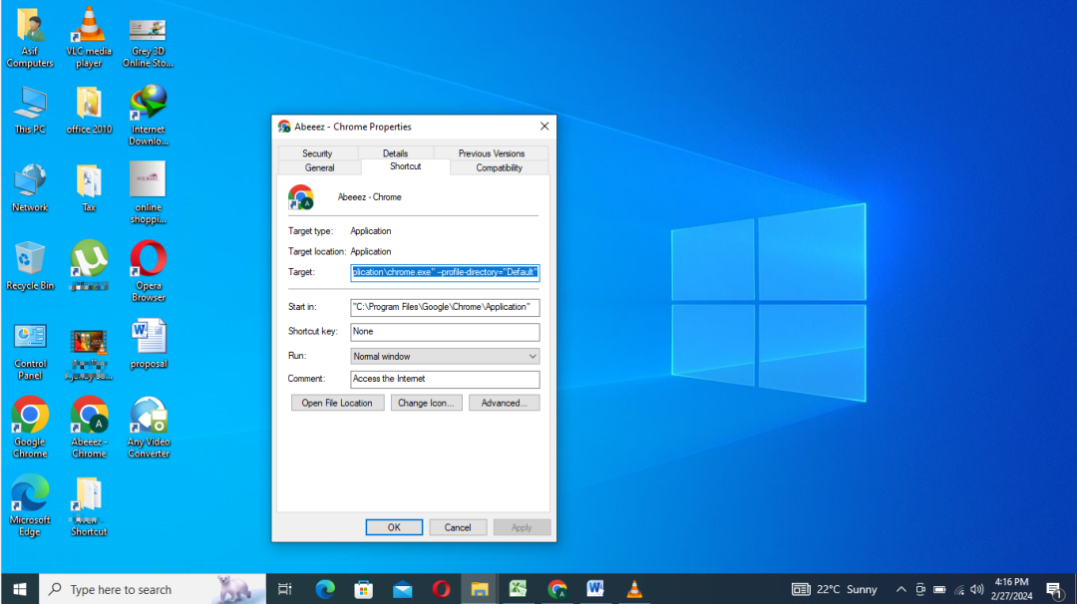
- Step 6:Chrome Full Screen Kiosk Mode
- After applying the above settings, the Chrome full screen kiosk mode will auto launch with a specific URL mentioned in the properties. If automatic full screen doesn't work on your Windows device, ensure Chrome is set as the default browser and fully closed before starting the setup process.
What This Method Can Do for You
- When used in conjunction with commands, you can customize various functionalities, such as disabling printers or restricting to a single tab.
Issues & Solutions of Chrome Kiosk Mode Created by Shortcut
Kiosk Mode Fails to Launch After Setup
When setting up Google Chrome Kiosk Mode in Windows, one of the most common issues you can encounter is that Chrome fails to launch after setup. This can happen for (usually) a couple of reasons:
- Incorrect Parameters: The kiosk mode doesn’t start if there is an error in the syntax of the command used to launch Chrome. Check your commands and make sure that there aren’t any misplaced spaces, quotation marks, and typos.
- User Permissions: Make sure that you have the necessary administrative privileges when setting up Chrome Kiosk Mode, or the kiosk mode will fail to launch.
- Conflicts with other Applications: Other applications might interfere with the kiosk mode. Before launching it, make sure to shut down any other application. In particular, make sure you shut down every service running in the background.
Unable to Limit Chrome Browser to a Single Tab
Chrome Browser Kiosk Mode is intended to open a single tab. A common issue that can occur is that, once launched the kiosk mode, Chrome allows multiple tabs, defeating the purpose of the kiosk mode. This can happen for several reasons and this is how you can troubleshoot it:
- Make sure you shut down the Chrome Browser completely before launching the kiosk mode.
- When creating the shortcut, in the Target field, add a starting page by typing: --kiosk http://www.xxx.com
Full Screen Shortcuts Doesn't Work
Sometimes, the Chrome Kiosk Mode can face issues with the full-screen shortcuts (like F11 or Ctrl+Shift+F) that don’t work.
This mainly happens because, when launched, correctly, Chrome is displayed full screen without the need to use shortcuts.
In particular, the command --kiosk launches Chrome, in kiosk mode, full screen. So, make sure you’ve used the right command, and there are no syntax errors, and Chrome will automatically launch full-screen, without any need for shortcuts.
Unable to Run HTML File in Chrome Kiosk Mode
Chrome Kiosk Mode is designed to display web-based content. So, by default, it may not allow to run HTML files for security restrictions. Therefore, to run HTML files, you need to provide the necessary permissions.
- Use this additional command --allow-file-access-from-files to enable Chrome to open local HTML files. The full command should look like this: --kiosk --allow-file-access-from-files
Task Manager Still Accessible in Chrome Kiosk Mode
When in Kiosk Mode, users might still be able to access the Task Manager. This should be fixed because, being able to access the Task Manager, users can exit the Chrome Kiosk Mode or interfere with it.
If you’re experiencing this issue, you can use Registry Editor to disable the task manager. This is how you do it:
- Open the Registry Editor by pressing Win+R and typing regedit
Navigate to the following:
HKEY_CURRENT_USER\Software\Microsoft\Windows\CurrentVersion\Policies\System
- In the System key, right-click in the right pane and select Nex, then DWORD (32-bit) Value
- Name the value DisableTaskMgr
- Double-click on DisableTaskMgr
- Set the value to 1
Difficult to Exit Kiosk Mode
Because the entire Windows system is locked into the Chrome Browser application, it can be tricky for admins to exit the kiosk mode.
When both shortcuts and task manager are disabled, the most effective way of exiting the Chrome kiosk mode on Windows is to restart the system and reset the session.
But make sure to avoid setting up the system to automatically boot the kiosk mode when restarting.
Chrome Settings or Session Data May Not Persist After Restart
When you want Chrome to persist after restart, you need to set the kiosk mode to be automatically launched upon restart.
To do so, after creating the Chrome Kiosk shortcut, you just need to place the shortcut folder in the Windows Startup folder. This will cause Chrome to start automatically whenever the system is restarted.
If you also want Chrome to restore the last data session upon restart, you need to add the command –restore-last-session when creating your shortcut. So, instead of only using –kiosk, you need to type --kiosk --restore-last-session
Chrome Extension Isn't Working
When Chrome extensions don’t work when the system in kiosk mode, you need to manually enable them by modifying the Kiosk Mode shortcut you’ve previously created. In particular, after locating the shortcut folder:
- Right-click on it and select Properties
- In the Target field, add the following command: --load-extension=”C:\path-to-extension-folder”
1.4 Corporate Windows PCs
Although configuring Chrome shortcuts to kiosk mode is suitable for most display scenarios, users who need batch settings and high security requirements still consider methods that strictly limit access and support remote configuration, monitoring, and troubleshooting..
The most appropriate method for business organizations to enforce Chrome kiosk mode on Windows devices is by using an MDM solution.
MDM enables enterprises to:
- Create and configure kiosk mode for multiple Windows devices remotely.
- Website whitelists: Restricting users to access only approved web pages for productive work and preventing data breaches from malicious sites.
- Customize Chrome Settings: Define browser restrictions based on business requirements.
- Step 1.Sign up and log into AirDroid Business admin console
- Click the free trial button below to sign up for an AirDroid Business account and use it to log into the admin console.
- Step 2.Create a profile for Chrome kiosk mode
- First, follow the AirDroid Business enrollment guide to bind your Windows devices to the admin console. Then, navigate to 'Policy & Kiosk', create a new Policy Config File for Windows, click 'Browser', select 'Open' on Browser Configuration, and complete the configuration of website allowlists.
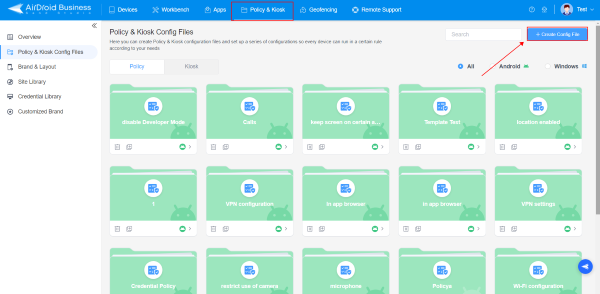
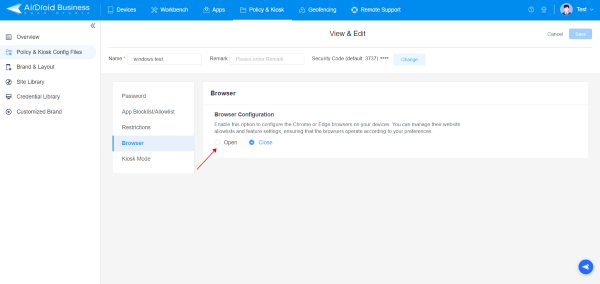
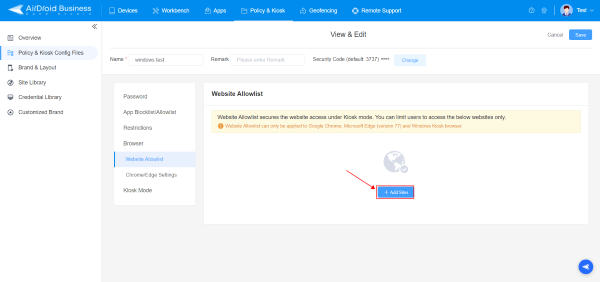
- Step 3.Build a custom Chrome browser
- Navigate to Chrome/Edge Settings to view a list of browser functions. Modify the settings according to your business needs.
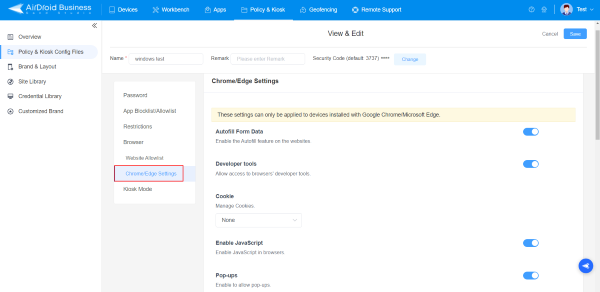
- Step 4.Kiosk Mode
- Move to 'Kiosk mode', select 'single-app mode', choose Google Chrome from the app list to ENABLE Chrome kiosk mode, complete the 'user account' setting and click save.
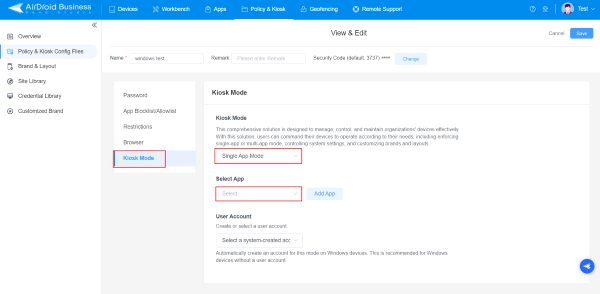
- Step 5.Apply settings to target Windows devices
- Apply this Policy Config File to your target Windows devices to finish kiosk mode configurations.
Here are some advanced features that provide optimized kiosk mode for businesses:
- Branding: In Kiosk mode, the administrator can customize the home screen and lock screen of Windows devices.
- Only Allow Access to a Specific URL: Setting kiosk mode with MDM software enables enterprises to add specific URLs to access by users on managed devices. It helps them ensure focused work with high productivity and engagement.
- Only the Admins Have Permission to Exit: The kiosk mode set on company devices using MDM software is highly secure and effective because MDM software allows only admins to exit kiosk mode from admin console. End-users can only use the device with restricted mode and not leave it themselves.
- Google Chrome Kiosk Configuration: The most powerful feature of MDM software for enterprises is the ability to remotely configure Chrome browser settings—such as security, basic, and network preferences—to create customized Chrome environments tailored to your specific needs.

2 Comparison of Different Set Up Methods/Configurations
Google Admin(MDM) vs. Shorcut Chrome Kiosk Mode
Google Admin is part of the MDM solution, so we can treat them as the same thing. Using an MDM solution to lockdown kiosk mode, users require a subscription(like Google Enterprise) to manage devices, but it provides a centralized management console from which you can control multiple devices remotely.
To set the Chrome Kiosk mode on a single device, you can use a combination of shortcut keys and commands. This method provides fast setup, but requires technical expertise for advanced configurations, such as blocking unnecessary browser functions, and lacks the ability to manage multiple devices from a single workstation. For broader device control, the MDM solution is more effective.
Multi-tab vs. Single-tab
No matter which method you use to configure Chrome Kiosk mode, Chrome will run in single-tab mode by default. This means the browser will be locked to a specific webpage or web app, and users will not be able to manually open new tabs or access other pages.
If you require multi-tab functionality, additional configuration is usually needed: you can use MDM policy settings or the --kiosk parameter combined with other settings to control the browser's behavior.
Auto-launch Kiosk vs. Public Session Kiosk
Google Admin supports two types of Kiosk modes—Auto-launch Kiosk and Public Session Kiosk—which are designed for different use cases.
Auto-launch Kiosk: This mode is intended for single-purpose devices, such as ordering kiosks (e.g., in restaurants) or hotel check-in terminals.
Functionality: When the device starts up, it automatically launches a specific application and enters full-screen mode. The browser typically operates in single-tab mode, locking users into a specific webpage and preventing them from exiting or accessing other functions.
Public Session Kiosk: This mode is designed for devices that require temporary access, such as library computers.
Functionality: allows multiple users to access the device without logging in and without retaining any user data after the session. This mode allows users to open multiple tabs on the Chrome browser and navigate freely across multiple websites.
3 Use Cases for Chrome Kiosk Mode
Chrome Kiosk mode can be deployed in many market sectors. The most frequent applications are the following:
Retail Self-Service Terminals
Devices locked in Chrome will be offered to customers. From these devices, clients can access a platform from which they can browse through the products or services, require a specific service, and check out.
It’s a method that helps retailers optimize their resources, avoid long queuing, and improve their customer’s experience and satisfaction level.
Meeting Room Sign-In
When an event requires guests to sign in when they access the meeting room, device locked in Chrome Kiosk mode can serve as a self-registration device.
Guests could sign in autonomously, registering their full set of data. It allows organizers to save money hiring registration staff.
This sign-in method also becomes very efficient for the subsequent data elaboration phase because the database will be ready and organized.
School Computer Labs
In this scenario, the lab computer can be locked into Chrome Kiosk mode to enhance the security of the students (they can’t access dangerous applications), improve their focus (they can’t access non-educational applications), and enhance the system’s security (students can access the computer’s settings).
Visitor Registration Desks
A device locked into Chrome Kiosk mode can serve as a visitor register. Instead of having visitors fill up a paper form, they can access a digital one. This way, data are automatically uploaded and labeled to be subsequently elaborated.
4 Key Takeaways
Setting up Chrome Kiosk mode on computers is one of the most effective and secure ways to lock them into a specific website or web application.
In scenarios like large education systems, that require advanced security features and access specific Google Chrome extensions, it would be essential to consult the Chrome Developer Dashboard or Admin Console. These would provide detailed configurations to tailor the security features strictly around the specific use environment needs.
Lastly, you should always make sure to have the last Chrome version running on the kiosk mode devices, especially if you need the browser to support multi-tab kiosk mode or specific extensions. It’s a simple but effective way to avoid unnecessary functional conflicts when the Chrome Kiosk mode is running.


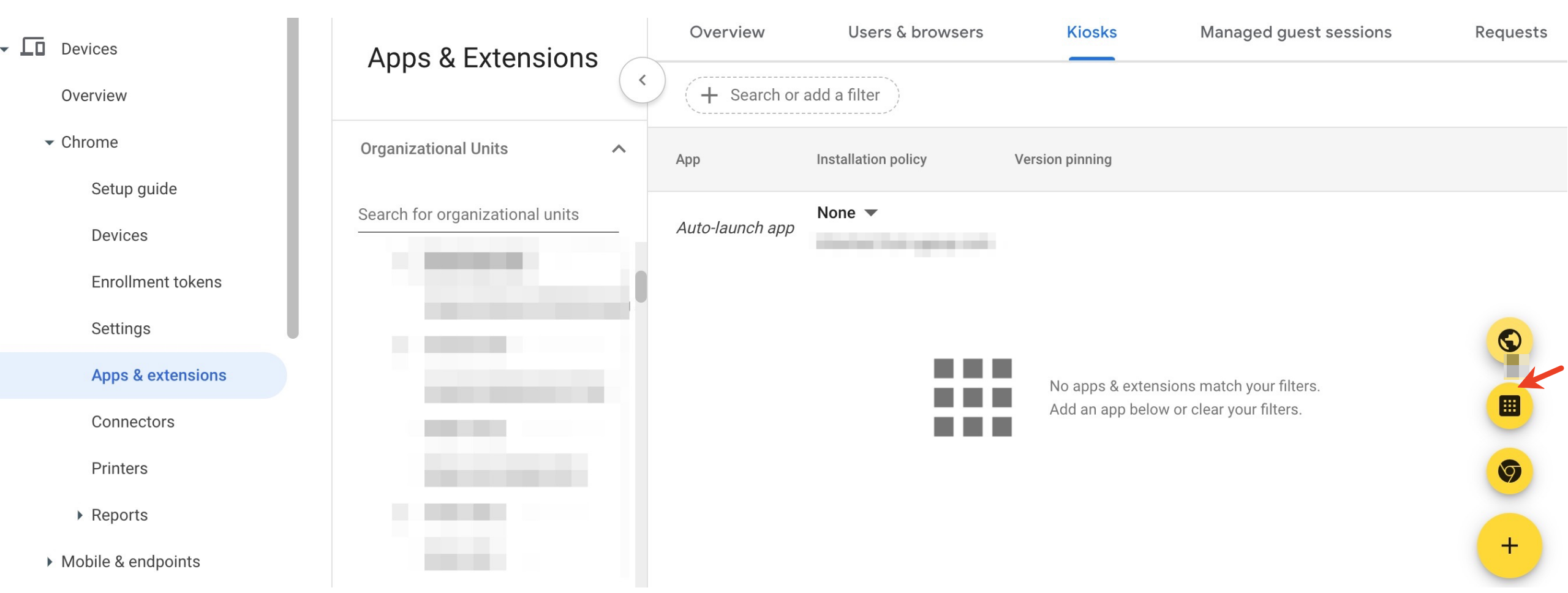
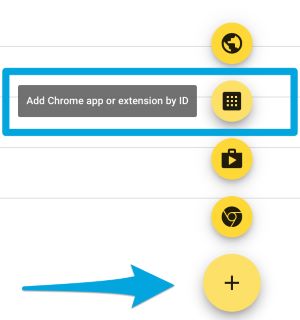
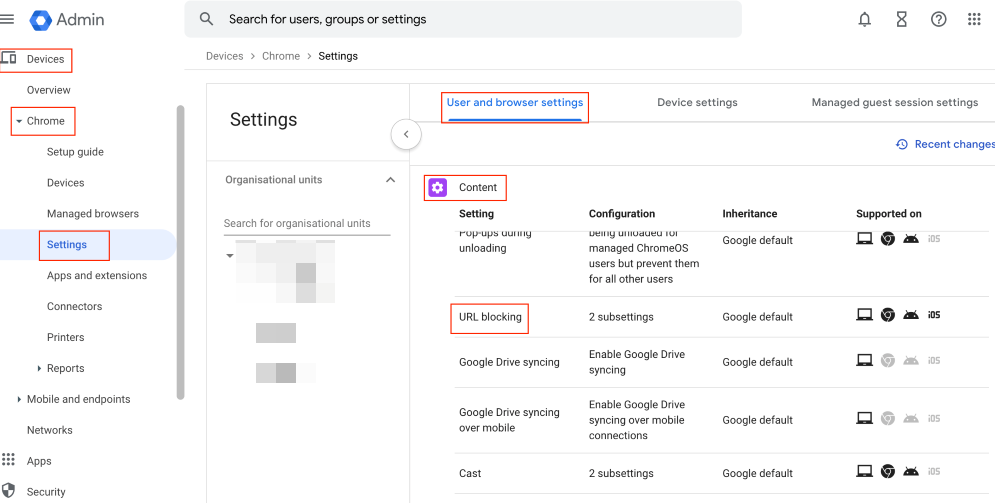

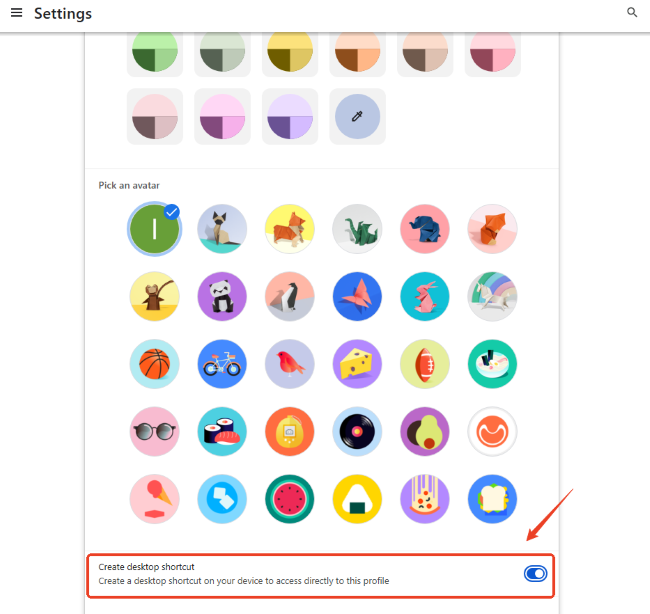
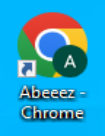
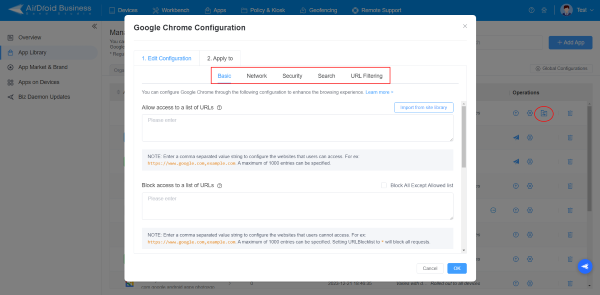
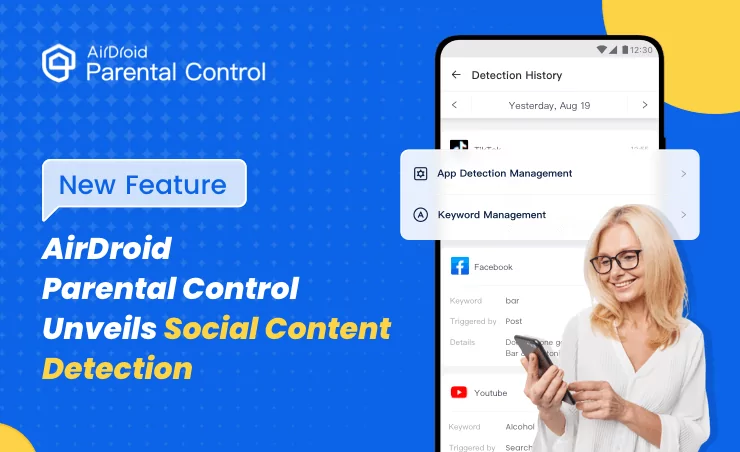
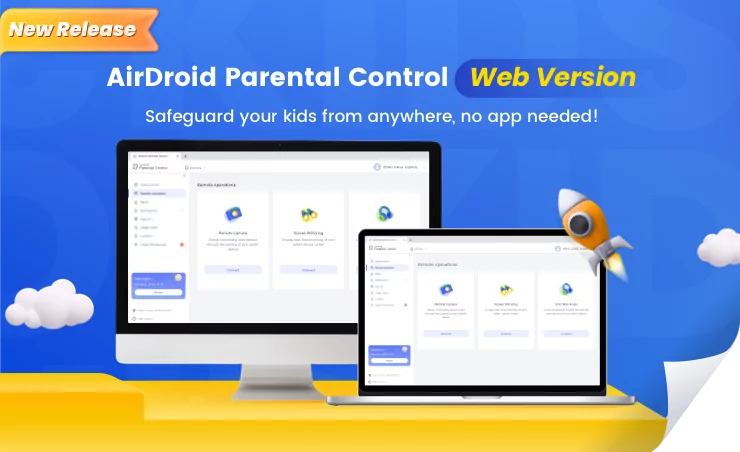
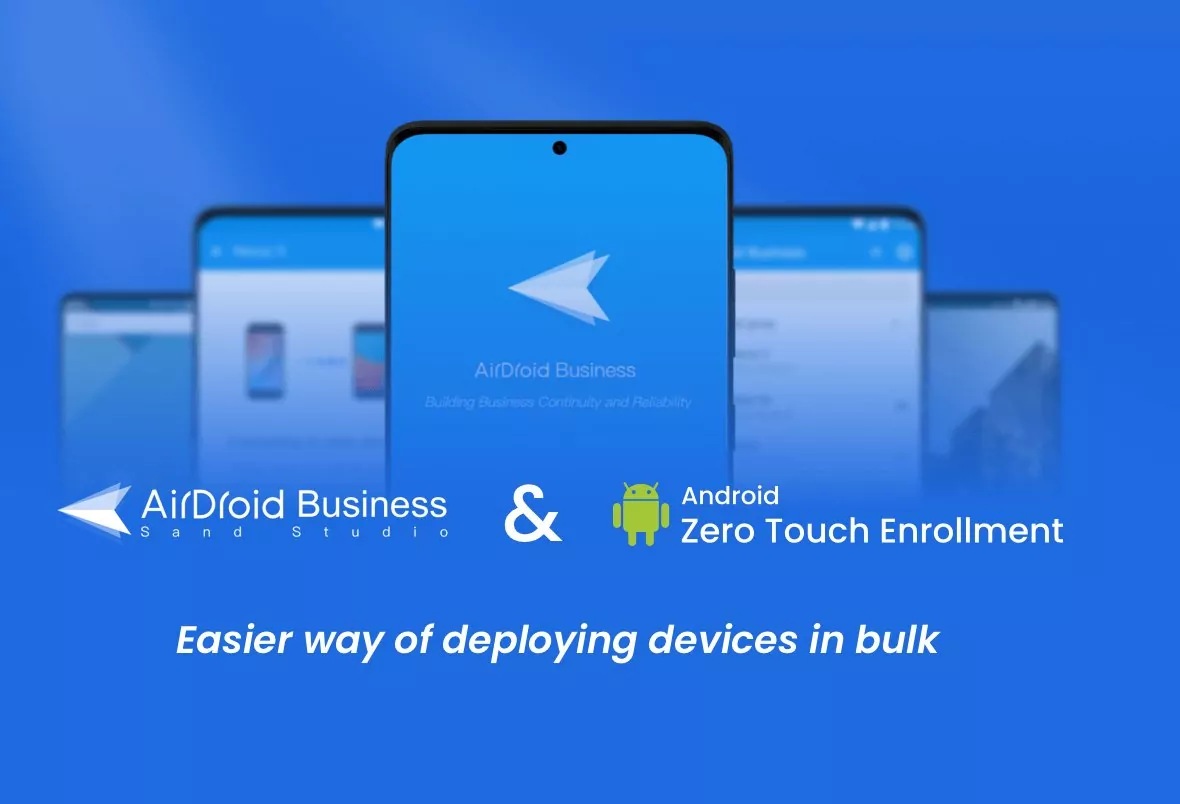
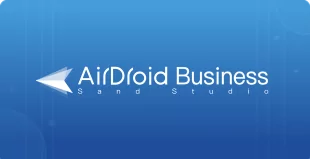
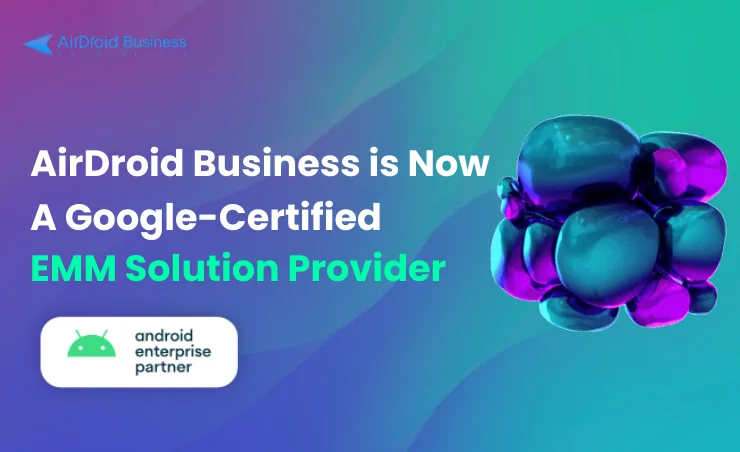



Leave a Reply.